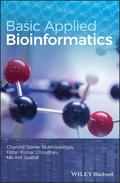Basic Applied Bioinformatics

1. Edition November 2017
472 Pages, Hardcover
Wiley & Sons Ltd
An accessible guide that introduces students in all areas of life sciences to bioinformatics
Basic Applied Bioinformatics provides a practical guidance in bioinformatics and helps students to optimize parameters for data analysis and then to draw accurate conclusions from the results. In addition to parameter optimization, the text will also familiarize students with relevant terminology. Basic Applied Bioinformatics is written as an accessible guide for graduate students studying bioinformatics, biotechnology, and other related sub-disciplines of the life sciences.
This accessible text outlines the basics of bioinformatics, including pertinent information such as downloading molecular sequences (nucleotide and protein) from databases; BLAST analyses; primer designing and its quality checking, multiple sequence alignment (global and local using freely available software); phylogenetic tree construction (using UPGMA, NJ, MP, ME, FM algorithm and MEGA7 suite), prediction of protein structures and genome annotation, RNASeq data analyses and identification of differentially expressed genes and similar advanced bioinformatics analyses. The authors Chandra Sekhar Mukhopadhyay, Ratan Kumar Choudhary, and Mir Asif Iquebal are noted experts in the field and have come together to provide an updated information on bioinformatics.
Salient features of this book includes:
* Accessible and updated information on bioinformatics tools
* A practical step-by-step approach to molecular-data analyses
* Information pertinent to study a variety of disciplines including biotechnology, zoology, bioinformatics and other related fields
* Worked examples, glossary terms, problems and solutions
Basic Applied Bioinformatics gives students studying bioinformatics, agricultural biotechnology, animal biotechnology, medical biotechnology, microbial biotechnology, and zoology an updated introduction to the growing field of bioinformatics.
ACKNOWLEDGEMENTS, xiii
LIST OF ABBREVIATIONS, xv
SECTION I Molecular Sequences and Structures
1 Retrieval of Sequence(s) from the NCBI Nucleotide Database, 3
2 Retrieval of Protein Sequence from UniProtKB, 9
3 Downloading Protein Structure, 15
4 Visualizing Protein Structure, 19
5 Sequence Format Conversion, 23
6 Nucleotide Sequence Analysis Using Sequence Manipulation Suite (SMS), 31
7 Detection of Restriction Enzyme Sites, 43
SECTION II Sequence Alignment
8 Dot Plot Analysis, 53
9 Needleman-Wunsch Algorithm (Global Alignment), 59
10 Smith-Waterman Algorithm (Local Alignment), 67
11 Sequence Alignment Using Online Tools, 73
SECTION III Basic Local Alignment Search Tools
12 Basic Local Alignment Search Tool for Nucleotide (BLASTn), 81
13 Basic Local Alignment Search Tool for Amino Acid Sequences (BLASTp), 91
14 BLASTx, 103
15 tBLASTn, 109
16 tBLASTx, 113
SECTION IV Primer Designing and Quality Checking
17 Primer Designing - Basics, 121
18 Designing PCR Primers Using the Primer3 Online Tool, 125
19 Quality Checking of the Designed Primers, 139
20 Primer Designing for SYBR Green Chemistry of qPCR, 147
SECTION V Molecular Phylogenetics
21 Construction of Phylogenetic Tree: Unweighted ]Pair Group Method with Arithmetic Mean (UPGMA), 151
22 Construction of Phylogenetic Tree: Fitch Margoliash (FM) Algorithm, 159
23 Construction of Phylogenetic Tree: Neighbor ]Joining Method, 165
24 Construction of Phylogenetic Tree: Maximum Parsimony Method, 175
25 Construction of Phylogenetic Tree: Minimum Evolution Method, 183
26 Construction of Phylogenetic Tree Using MEGA7, 187
27 Interpretation of Phylogenetic Trees, 197
SECTION VI Protein Structure Prediction
28 Prediction of Secondary Structure of Protein, 211
29 Prediction of Tertiary Structure of Protein: Sequence Homology, 217
30 Protein Structure Prediction Using Threading Method, 223
31 Prediction of Tertiary Structure of Protein: Ab Initio Approach, 229
32 Validation of Predicted Tertiary Structure of Protein, 235
SECTION VII Molecular Docking and Binding Site Prediction
33 Prediction of Transcription Binding Sites, 243
34 Prediction of Translation Initiation Sites, 251
35 Molecular Docking, 257
SECTION VIII Genome Annotation
36 Genome Annotation in Prokaryotes, 265
37 Genome Annotation in Eukaryotes, 269
SECTION IX Advanced Biocomputational Analyses
38 Concepts of Real ]Time PCR Data Analysis, 275
39 Overview of Microarray Data Analysis, 283
40 Single Nucleotide Polymorphism (SNP) Mining Tools, 289
41 In Silico Mining of Simple Sequence Repeats (SSR) Markers, 299
42 Basics of RNA ]Seq Data Analysis, 305
43 Functional Annotation of Common Differentially Expressed Genes, 313
44 Identification of Differentially Expressed Genes (DEGs), 325
45 Estimating MicroRNA Expression Using the miRDeep2 Tool, 357
46 miRNA Target Prediction, 365
Appendices
Appendix A: Usage of Internet for Bioinformatics, 377
Appendix B: Important Web Resources for Bioinformatics Databases and Tools, 381
Appendix C: NCBI Database: A Brief Account, 389
Appendix D: EMBL Databases and Tools: An Overview, 395
Appendix E: Basics of Molecular Phylogeny, 403
Appendix F: Evolutionary Models of Molecular Phylogeny, 411
GLOSSARY, 415
REFERENCES, 423
WEBLIOGRAPHY, 431
INDEX, 435
Chandra Sekhar Mukhopadhyay is an Assistant Scientist (Senior Scale) at the School of Animal Biotechnology, Guru Angad Dev Veterinary and Animal Sciences University (GADVASU) at Ludhiana, Punjab, India.
Ratan Kumar Choudhary is an Assistant Professor at the School of Animal Biotechnology, Guru Angad Dev Veterinary and Animal Sciences University (GADVASU) at Ludhiana, Punjab, India.
Mir Asif Iquebal is a Scientist at the Centre for Agricultural Bioinformatics, Indian Council of Agricultural Research-Indian Agricultural Statistics and Research Institute (ICAR-IASRI) at Pusa, New Delhi, India.


